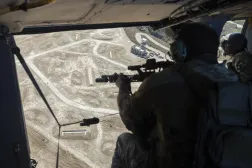Nominee for top U.S. military post notes shortfalls in electronic warfare integration

The U.S. military’s integration of electronic warfare into operations remains a “work in progress” and the Pentagon has lost “muscle memory” when it comes to defending against electromagnetic attacks, according to President Biden’s nominee to be the next chairman of the Joint Chiefs of Staff.
In response advance policy questions — a questionnaire senators pose to nominees for high-level positions prior to their confirmation hearings — Gen. Charles “CQ” Brown noted the joint force needs to do more on the EW front.
“This is a work in progress, and the biggest block to doing this is a mindset shift,” Brown, who is currently the Air Force chief of staff, replied to a question asking if the Department of Defense has adequately integrated electronic warfare into joint concepts and operational plans. “Often we think of electromagnetic warfare as a supporting effort to enable some other weapon system or capability. In modern warfare, electromagnetic warfare may be the main effort to achieve the desired strategic effects, especially in the pre-conflict phase where we ideally deter a fight from happening in the first place. Our joint concepts and operational plans are progressing towards this reality, but I think we have room for improvement.”
Following the end of the Cold War, the DOD largely divested of much of its high-end electronic warfare capabilities. Now, adversaries recognize the U.S. military’s dependence on the spectrum and its strategic importance. The joint force relies on the spectrum for communications and navigation — to include precision strike, GPS and data. Adversaries have developed sophisticated systems to jam, spoof and confuse U.S. capabilities.
Now, in many cases, the U.S. military is playing catch-up in both trying to develop offensive jamming capabilities to attack enemy systems while developing tools to defend against them. The spectrum is a maneuver space that involves a cat-and-mouse game of continuous countermeasures as nations try to gain advantages relative to adversaries.
“Electromagnetic warfare operations are dynamic. U.S., allied, partner, and adversary capabilities in the electromagnetic maneuver space are constantly changing, which creates perpetual challenges to get the right capability to the right warfighter at the right time to be operationally relevant against the right threat,” Brown wrote.
Previously, Brown has recognized that the spectrum can be more cost-effective than traditional kinetic capabilities, such as munitions, given they provide a nearly unlimited magazine.
“In some aspects, an electron is much cheaper than a very expensive missile … We’ve got to think about the cost curve” and be able to conduct both the kinetic and non-kinetic attacks, he said in 2021, adding that the Air Force had been “asleep at the wheel” for the last 25 to 30 years within the spectrum.
Regarding whether or not DOD systems are adequately protected from enemy electronic attack, Brown noted in his advance policy questionnaire that the answer depends on adversaries’ capabilities.
Challenging factors include that the joint force has lost some muscle memory defending against electronic attack over the last 20 years as it was busy conducting operations against technologically inferior adversaries in a permissive environment. Additionally, operations in the spectrum during that same time have changed while adversaries have evolved.
“If confirmed, I am committed to ensuring that we continue to invest in additional capabilities in the electromagnetic spectrum,” Brown said.
He also recognized that the DOD is not adequately conducting “Tier One” exercises utilizing adversary-level electronic warfare tools. Tier one exercises are focused on the national level or combatant command level.
Integrating electronic warfare capabilities into exercises can be challenging for a number of reasons. For one, access to the spectrum is finite and using jammers can adversely affect civilian capabilities such as airplanes and first-responder capabilities. Turning on these jammers can also provide adversaries that might have passive sensing capabilities deployed near U.S. forces the ability to collect on those signals and develop counters to them.
“Our Combatant Commanders recognize the critical importance of electronic warfare and prioritize the objectives of their Tier One exercises accordingly, tailored to the threats within their geographic or functional areas of responsibility, but frequently the objectives of the exercise and limited threat replication capabilities overcome the realism of the exercise,” Brown wrote.
“Electronic warfare continues to evolve rapidly, and we must forecast and preemptively update our training to remain dominant. Our Joint Warfighting Concept emphasizes the importance of the electromagnetic spectrum and provides a unified approach to shape joint force exercises. A live, virtual, constructive (LVC) simulation environment will be essential in this effort. If confirmed, I will ensure the Joint Staff issues guidance on the realism of the training events,” he added.






